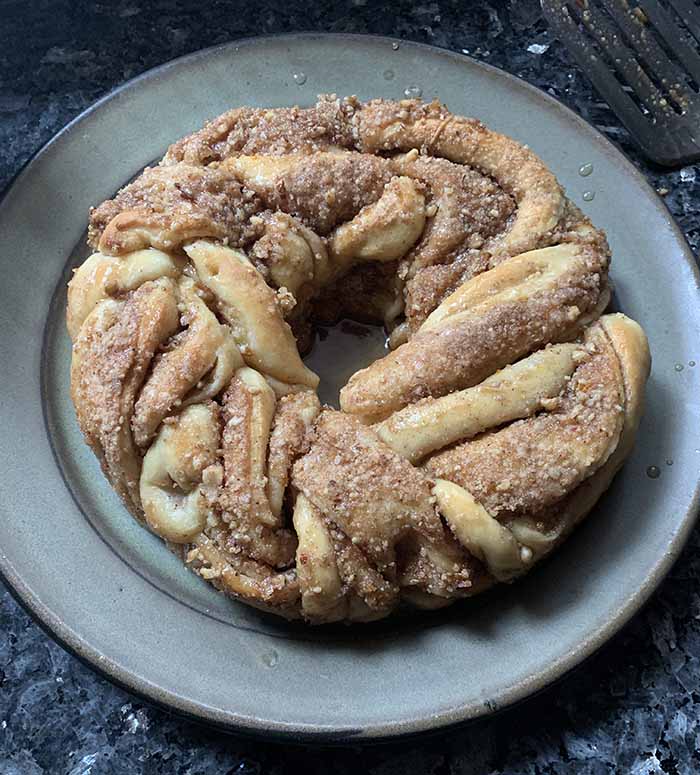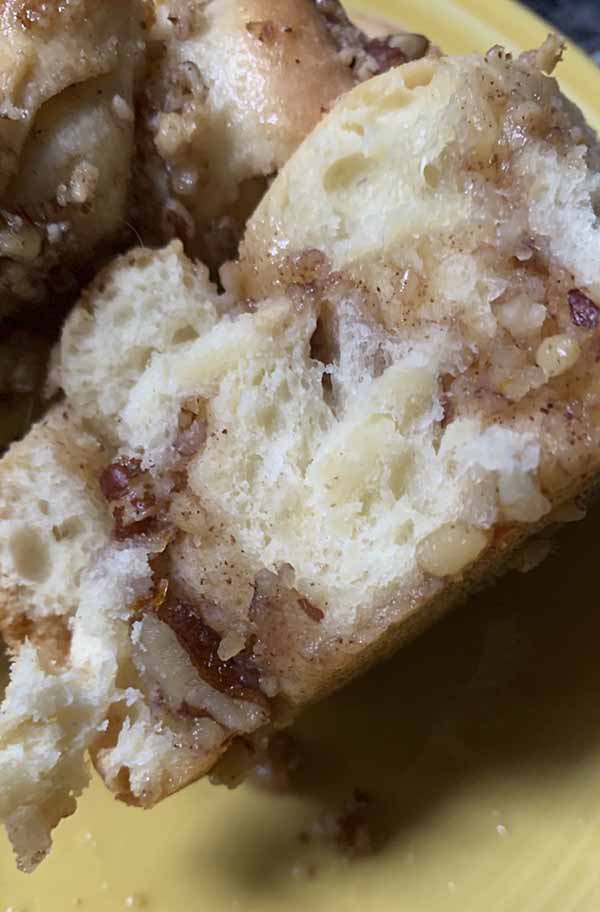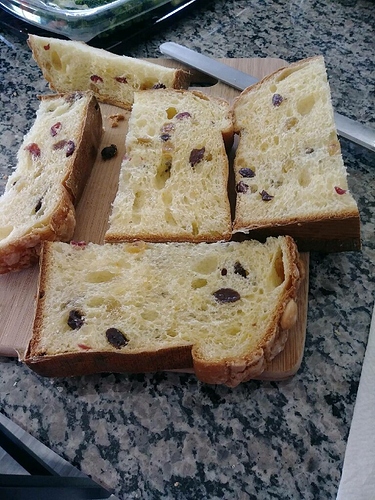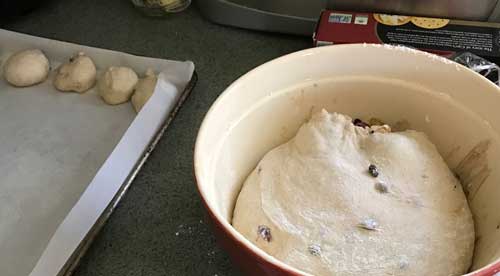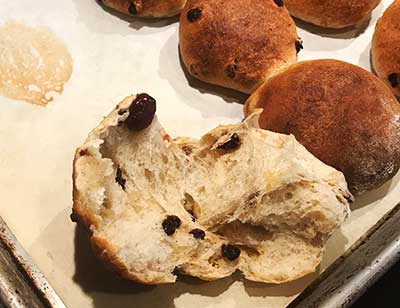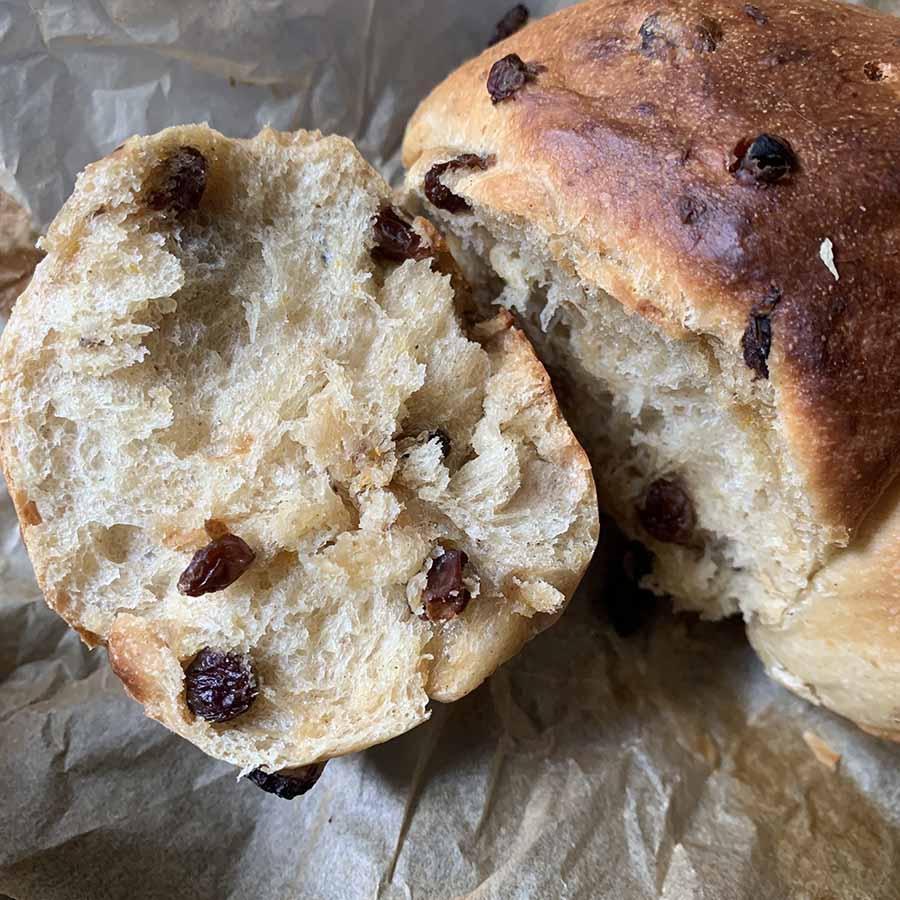My obsession with making panettone began when I stumbled on a recipe in a bread machine recipe book over a decade ago. I quickly graduated from the bread machine recipe to other domestic, yeasted recipes, but I always found them a bit lacking lacking in flavor and without that soft, silky “mouth feel” you get from a good panettone. About 5 years ago, I got serious about making a panettone strictly with natural leavening. (It is the reason why I originally purchased my sourdough starter from Breadtopia!) I finally decided that if I really wanted an authentic Milanese panettone, I should be looking for recipes from the Italian panettone masters. After several years of mediocre (and failed!) attempts, I eventually settled on a recipe from the Milanese master, Iginio Massari. I got it through an Italian baking blog site called Fables de Sucre. The recipe makes 2 500 g panettones, though I usually scale up the recipe to make 3 or 4 at a time. Link below:
Disclaimer: The site is entirely in Italian. However, many browsers now incorporate translation engines. I found that Google Translate (augmented by that year of college Italian I took back in my foolish youth) did a reasonable job of translation. Their instructions were pretty good, once you get around some of the awkward translations. They also have a very good general tutorial on making your own panettone, including tips on maintaining your sourdough starter specifically for panettone. Here is the link (again, page is in Italian):
I personally think that using natural leavening helps soften the gluten (along with all the egg yolks and butter!) to give that soft, silky crumb that I love. It also contributes a complexity to the flavor profile.
I start prepping my starter about 2 weeks prior to my first panettone bake. First, I convert my 100% hydration starter into a stiff starter (50% hydration) and start refreshing it every 12 hours (with bread flour to increase the gluten content). I keep it in my proofing box, starting at 75 degrees F and then slowly ramping up the temperature a couple degrees every few days until I get to 85 degrees F just before I am ready to bake. The goal here is to make sure the starter is active enough to triple in volume within 4 hours after refreshment. I also monitor the pH of the starter (with pH paper), targeting an optimal pH of 4.0 – 4.5. If the sourdough is too acidic (lower pH number), I do a double refreshment and if it is not acidic enough, I increase the proportion of starter to refreshment flour/water.
Then, the day before mixing the first dough, I start feeding the starter every 4 hours, making sure that the starter triples in volume each time. Instead of getting up every 4 hours overnight, for the last refreshment of the day I adjust the starter hydration down to 40% and then form it into a log, cover it in cling wrap, wrap it in a stout kitchen towel and bind it with a strong cord, sort of like a salami. This slows the starter maturation process so that it does not get too acidic for 8 hours over night. Remember, the goal of the 4 hour refreshment schedule is to minimize the acidity of the starter so that you don’t get that soughdough “twang” in your sweet panettone. The link below describes the starter binding process, again in Italian.
During that second day of 4 hour refreshments, I prepare the aromatic mixture, though I use vanilla extract instead of using vanilla beans. (I substitute 2 – 3 tsp of vanilla extract for 1 vanilla bean. Someday I’ll spend the money to actually use real vanilla beans.) That evening, I mix my first dough. I pretty much follow the Fables de Sucre recipe as written, with just a couple tweaks. First, I use high gluten flour for panettone. A good panettone will rise up to 6 times the original volume of the dough and that requires some pretty strong gluten, especially since you add so many egg yolks and so much butter. I got some General Mills All Trumps Flour with 14.2% protein from an on-line website. I also found that I had to add more water to the first dough than the recipe called for, just to get the dough to come together before adding the egg yolks and butter. Once the dough is done (passes the window pane test), I put it in a large cylindrical food-grade container, mark the dough level and put it in the proofing box at 85 degrees F over night.
Before going to bed, I prepare the dried fruit inclusions. I am not a huge fan of the candied fruit rind used in traditional panettones, so I substitute a combination of raisins, golden raisins and dried cranberries. I use equal amounts of each for a total weight that corresponds to the same total weight of raisins + candied fruit rinds listed in the Fables de Sucre recipe. To re-hydrate the raisins, I use equal amounts of water and white rum to just cover them. For the dried cranberries, I use equal amounts of water and brandy. I cover the containers with cling wrap and let them soak over night.
The next morning I drain raisins/cranberries and remove the excess moisture with paper towels. By this time, the first dough should have tripled in volume after rising for about 12 hours. I follow the recipe for the second dough pretty much verbatim, except I only add about half the water listed in the recipe. Note, I pre-load long wooden skewers (11.75”) into the panettone molds before placing the final dough into them, as recommended by the Wild Yeast blog. I also have reduced the amount of dough they specify per loaf from 550g to 530g for a 5.25” panettone mold. After loosely covering the loaded molds with plastic bags, its back into the proofing box for the final rise. It takes another 8 – 10 hours or so before the dough crests above the panettone molds and is about ½ inch below the top of the mold at the sides.
Before going in the oven, I like to use a hazelnut almond topping with some Swedish pearl sugar on my panettone. I got that recipe from the Martha Stewart web site from an Italian master baker by the name of Gabriele Riva. He also has his own panettone recipe there.
I bake them, as in the recipe, for 50 minutes at 329 degrees F until the internal temperature is at least 201 degrees F. . Well, here are the results…

 … but I’m jumping in with at least a comment as I’ve made/been making sweet rolls, doughnuts (with a Brioche dough) and since Christmas an adaptation of
… but I’m jumping in with at least a comment as I’ve made/been making sweet rolls, doughnuts (with a Brioche dough) and since Christmas an adaptation of 